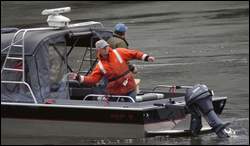forum
library
tutorial
contact

Hazing Not Keeping Sea Lions Away
by StaffStatesman Journal, April 23, 2007
|
the film forum library tutorial contact |

|
Hazing Not Keeping Sea Lions Awayby StaffStatesman Journal, April 23, 2007 |
More fish are falling victim to hungry mammals
 By the numbers, California and stellar sea lions killed 421 salmon and steelhead and sturgeon at Bonneville Dam on the Columbia River this year through April 4.
By the numbers, California and stellar sea lions killed 421 salmon and steelhead and sturgeon at Bonneville Dam on the Columbia River this year through April 4.
Army Corps of Engineers figures for predation below the dam are 216 steelhead, 64 Chinook salmon, and 141 "salmonid" in which the species could not be determined.
Of the sturgeon taken, 55 were recorded as being 5 feet or longer, which is spawning size.
"In terms of California sea lions, it's very similar to last year, and their numbers are increasing," said Steve Williams.
Earlier this month Williams, the assistant Fish Division administrator, gave a briefing about hazing efforts on the sea lions to members of the Oregon Fish and Wildlife Commission.
It's too early to tell how successful the efforts are going to be, but the number of the large predators gets bigger every year.
"Our hazing efforts, I would say, have a limited effect," Williams said about the California sea lions that prey mainly on salmon and steelhead.
"We are able to move some animals around, but I think the jury's still out on whether we're going to be successful."
The larger stellars that are claiming most of the sturgeon are more responsive to the hazing efforts using underwater fireworks and rubber buckshot, he said.
"We've had some success with the stellar sea lions," Williams said. "We think we have an issue, a substantial issue, just like last year with sturgeon predation.
"And when we began in March for just a couple of days, we were able to move most of the stellar sea lions, not all but most, out of the area and drop the predation substantially."
But the hazing efforts are concentrated near Bonneville and downriver to Marker 85, a distance of about seven miles, he said.
And there have been sightings of stellars taking sturgeon as far downriver as Astoria at the mouth, Williams said.
"We don't know how many fish are being taken, but we know it's increasing, and the number of animals is increasing," he said. "And that's a great concern."
A Section 120 application by officials in Oregon, Washington and Idaho is grinding slowly through the federal process.
If approved -- probably years down the road -- it would allow an exemption to the Marine Mammal Protection Act to kill a limited number of sea lions at Bonneville that have been identified as preying on salmon that are protected under the federal Endangered Species Act.
During the 60-day public comment period on the application, more than 300 comments were submitted to the National Marine Fisheries Service, Williams said.
"Almost all of them supportive in one way or another of some form of lethal removal of sea lions," he said.
While the process is long and frustrating, there is no such relief in sight for dealing with the sturgeon predators, Williams said.
"That's being done by the stellar sea lions, which are a (federally) listed species," he said. "So short of just hazing efforts, it's going to be very difficult in dealing with those animals in the situation in the Columbia River."
learn more on topics covered in the film
see the video
read the script
learn the songs
discussion forum
